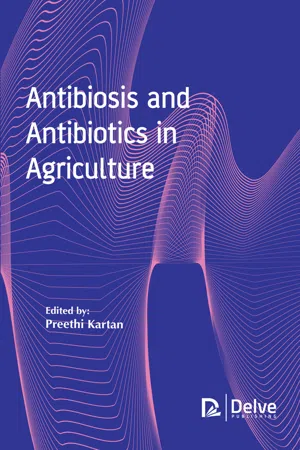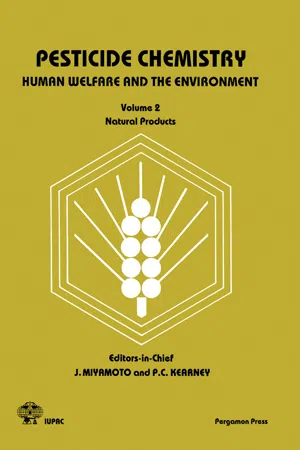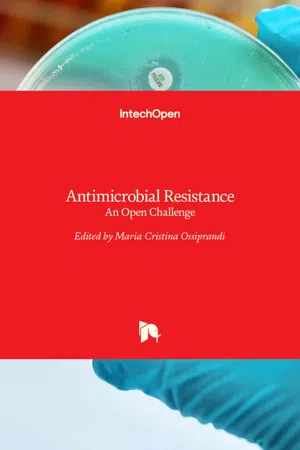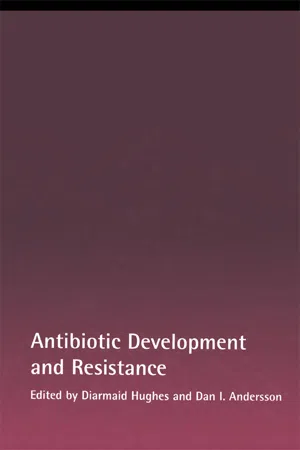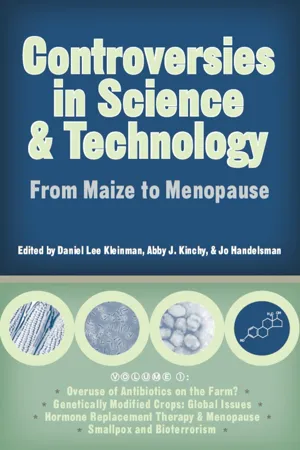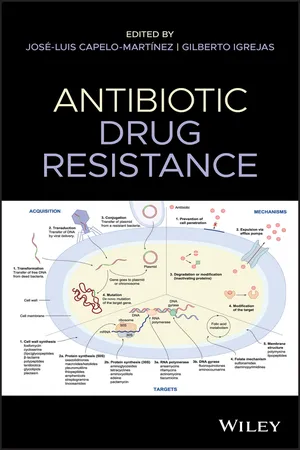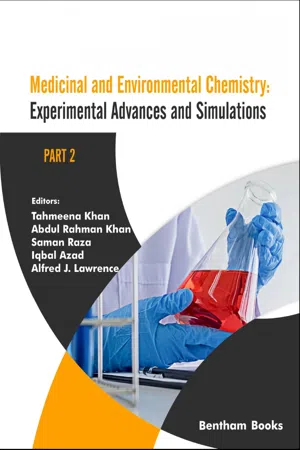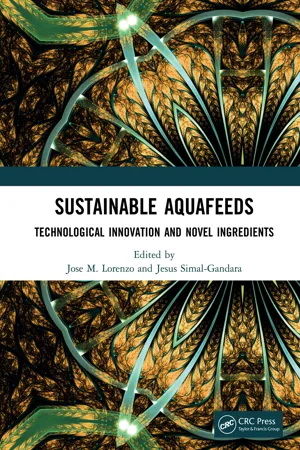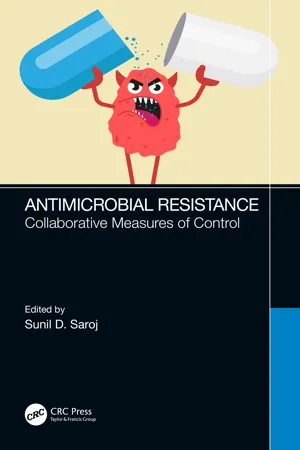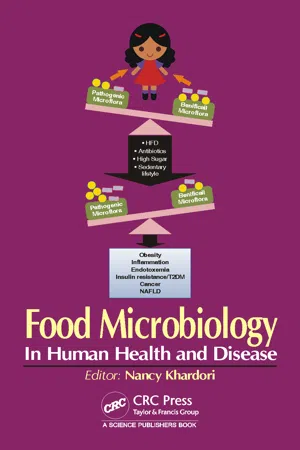Geography
Antibiotics in Agriculture
Antibiotics in agriculture refers to the use of these drugs in livestock farming to promote animal growth and prevent diseases. Concerns have been raised about the potential environmental and human health impacts of antibiotic use in agriculture, including the development of antibiotic-resistant bacteria and the presence of antibiotic residues in the environment. This practice is a significant issue in the global agricultural industry.
Written by Perlego with AI-assistance
Related key terms
1 of 5
11 Key excerpts on "Antibiotics in Agriculture"
- eBook - PDF
- Preethi Kartan(Author)
- 2019(Publication Date)
- Delve Publishing(Publisher)
Antibiotics use in agriculture and their impact on terrestrial environment. Adv. Agron. 2005;87:1–54. doi: 10.1016/S0065-2113(05)87001-4. 229. Beuchat L.R. Ecological factors influencing survival and growth of human pathogens on raw fruits and vegetables. Microbes Infect. 2002;4:413–423. doi: 10.1016/S1286-4579(02)01555-1. 230. Johannessen G.S., Loncarevic S., Kruse H. Bacteriological analysis of fresh produce in Norway. Int. J. Food Microbiol. 2002;77:199–204. doi: 10.1016/S0168-1605(02)00051-X. 231. Baquero F., Martínez J.-L., Cantón R. Antibiotics and antibiotic resistance in water environments. Curr. Opin. Biotechnol. 2008;19:260– 265. doi: 10.1016/j.copbio.2008.05.006. 232. Vaz-Moreira I., Nunes O.C., Manaia C.M. Bacterial diversity and antibiotic resistance in water habitats: Searching the links with the Antibiosis and Antibiotics in Agriculture 264 human microbiome. FEMS Microbiol. Rev. 2014;38:761–778. doi: 10.1111/1574-6976.12062. 233. Taylor N.G.H., Verner-Jeffreys D.W., Baker-Austin C. Aquatic systems: Maintaining, mixing and mobilising antimicrobial resistance? Trends Ecol. Evol. 2011;26:278–284. doi: 10.1016/j.tree.2011.03.004. 234. Aryal S., Karki G., Pandey S. Microbial diversity in freshwater and marine environment. Nepal J. Biotechnol. 2015;3:68–70. doi: 10.3126/ njb.v3i1.14236. 235. Ibekwe A.M., Ma J., Murinda S.E. Bacterial community composition and structure in an urban river impacted by different pollutant sources. Sci. Total Environ. 2016;566–567:1176–1185. doi: 10.1016/j. scitotenv.2016.05.168. 236. Cabral J.P.S. Water Microbiology. Bacterial Pathogens and Water. Int. J. Environ. Res. Public Health. 2010;7:3657–3703. doi: 10.3390/ ijerph7103657. 237. Biyela P.T., Lin J., Bezuidenhout C.C. The role of aquatic ecosystems as reservoirs of antibiotic resistant bacteria and antibiotic resistance genes. Water Sci. Technol. 2004;50:45–50. 238. Nogales B., Lanfranconi M.P., Piña-villalonga J.M., Bosch R. - eBook - PDF
Natural Products
Proceedings of the 5th International Congress of Pesticide Chemistry, Kyoto, Japan, 29 August - 4 September 1982
- N. Takahashi, H. Yoshioka, T. Misato, N. Takahashi, H. Yoshioka, T. Misato(Authors)
- 2013(Publication Date)
- Pergamon(Publisher)
ANTIBIOTICS FOR AGRICULTURAL USE This page intentionally left blank RECENT STATUS AND FUTURE ASPECTS OF AGRICULTURAL ANTIBIOTICS Tomomasa Misato institute of Physical and Chemical Research, Wako, Saitama 351, Japan Abstract - Nowadays, use of agricultural antibiotics is not been limited only to controlling plant diseases, but is ex-tended wider over various areas such as insecticidal and herbi-cidal uses, or as plant regulators in Japan. Here, the author intends to consider the reasons why so much is expected of antibiotics of microorganic origin as pesticides, and he also wishes to present a brief introduction to the present situation of antibiotic research and development in the country. INTRODUCTION In today's world where the population is constantly increasing, an increase in food production is essential. Pesticides have been playing epoch-making role in stabilizing and increasing crop yield. Yet, on the other hand, pesticides are accused of being possible source of environmental pollution with residual toxicity harmful to mammals, and wildlife. This soicial concern is urging the exploitation of non-polluting safe pesticides. Antibiotics are produced by soil microorganisms in the soil. The advantage of their being derived from and returned to the soil have made antibiotics model pesticides which do not cause environemtal problems. Studies on the use of antibiotics for agricultural purposes were first started in Europe and the United States, stimulated by the remarkable pro-gress in the medical field since the tank culture method for penicillin pro-duction was developed. The energetic efforts did not bear so much fruit as expected, leading only to the use of streptomycin (which had been used for medical purposes) combined with tetracyclin for the control of bacterial diseases of fruit trees and vegetable diseases. The consumption of cyclo-heximide (U.S.A.) and griseofluvin (U.K.), both developed as agricultural antibiotics, was also very limited. - eBook - PDF
Antimicrobial Resistance
An Open Challenge
- Maria Cristina Ossiprandi(Author)
- 2015(Publication Date)
- IntechOpen(Publisher)
To extend the time that antibiotics can be effectively used in human and veterinary medicine, agricultural management options are necessary to reduce the environ‐ mental release and spread of antibiotics and antibiotic resistance determinants. Policy makers are focusing on agricultural sources of antibiotic resistance as a result of recent reports that emphasize the importance of antibiotic resistance in environmental bacteria (pathogenic and non-pathogenic) as a point source for spread to environmental and human ecosystems.[6,19– 24] These findings, coupled with the potential for spread of emergent antibiotic-resistant bacteria from livestock to human populations and the lack of new antibiotics entering the market, have placed pressure on the agricultural community, increasing the urgency for science-based studies that fill gaps in current knowledge about how antibiotic resistance spreads within environmental ecosystems. Furthermore, on a policy level, there is urgent need for criteria and methods that allow reliable and reproducible assessment of risks associated with realistic concentrations of different classes of antibiotics, resistance determinants, and mobile genetic elements applied to soil with organic fertilizers such as manure or digestates. In this chapter, we will summarize recent advances, limitations, and research needs regarding approaches to quantify and evaluate the effects and risks associated with veterinary antibiotics Antimicrobial Resistance - An Open Challenge 18 and resistance determinants applied to soil through manure fertilization. - eBook - ePub
- Diarmaid Hughes, Dan I Andersson, Diarmaid Hughes, Dan I Andersson(Authors)
- 2001(Publication Date)
- CRC Press(Publisher)
Debates on antibiotic resistance have centered on livestock animals such as pigs, chickens and cattle. Yet, antibiotics are also used by vegetable and fruit growers and in aquaculture. Use in these areas may have as great an impact on human health and the environment as antibiotic use in animal production. Another area deserving more attention is the antibiotic resistant bacteria in the intestines of companion animals. Antibiotic-resistant bacteria in dog or cat food could be spread to companion animals and through them to humans. No one disputes the important contribution to the spread of antibiotic-rersistant bacteria made by the abuse and overuse of antibiotics in human medicine. The fact that this is probably the main cause of the rise in antibiotic resistance, however, is not an argument for ignoring antibiotic overuse and abuse in agriculture. The public views the use of antibiotics to treat human infections as necessary and desirable. By contrast, most agricultural uses other than treatment of sick animals, appears to those who know little about it to be optional and in some cases frivolous. Thus, the public may support an end to use of antibiotics as growth promoters or as plant protection agents despite the fact that these uses probably do not make as great a contribution to resistance in human pathogens as human clinical use. Moreover, it is important to realize that the extent of the contribution agricultural use of antibiotics makes to resistance in human pathogens has not been established. It may be greater than we think.Perhaps the most serious difficulty in trying to define safe and prudent use of Antibiotics in Agriculture is that antibiotics may not be the only selective pressure maintaining antibiotic-resistance genes in the environment. Antibiotic resistance genes can be genetically linked to other genes such as metal resistance genes. In such cases, metal pollution could select for resistance to antibiotics as well as resistance to the metal in question. Studies of the effects of antibiotic use in human medicine or agriculture seldom establish a resistance baseline in the surrounding area of the site being tested. Nor do they establish whether the resistances they detect are linked to some other trait that could be the actual target for local selective pressures. Langlois et al. - eBook - PDF
- Kumar, Arvind(Authors)
- 2021(Publication Date)
- Daya Publishing House(Publisher)
rapid overview of some developments in respect of the current use of antibiotics on plants, their detrimental effect on environment, the emergence of antibiotic-resistant strains of plant pathogens, and the possible socio-economic fallout of antibiotic use on environment and human health that can have a deep impact on the use of antibiotics in plant disease management is presented. Use of Antibiotics Against Plant Diseases The targets of antibiotic use on plants are pathogenic bacteria and other prokaryotic microbes (e.g., phytoplasmas). Managing bacterial diseases depends mostly on host plant resistance (which may not be available in desirable crop varieties), quarantine (preventing the introduction of pathogens), sanitation (removing diseased plant tissues), and cultural practices (e.g., avoiding overhead irrigation and limiting nitrogen fertilization). In some cases, chemical bactericides (e.g., copper compounds and antibiotics) and biological control agents are effectively integrated into the disease management programme. Major Antibiotics in Plant Disease Management The classic definition of an antibiotic is a compound produced by a micro-organism that inhibits the growth of another micro-organism. Of the myriad antibiotics used in agriculture, only two are used on plants in the U.S. streptomycin and oxytetracycline. Streptomycin Streptomycin is an amino glycoside antibiotic. The primary mechanism of action of streptomycin is binding irreversibly to bacterial ribosomes and thereby inhibiting protein synthesis. Streptomycin use is registered on 12 plant species, but the primary uses are on apple, pear, and related ornamental trees for the control of fire blight caused by Erwinia amylovora ( Table 7.1 ). Minor uses include floriculture, seed treatment, and on certain vegetable seedlings in the greenhouse and/or field. At high concentrations, streptomycin can be phytotoxic to plants; thus it is applied to the surface of plants and not injected. - eBook - PDF
Controversies in Science and Technology
From Maize to Menopause
- Daniel Lee Kleinman, Abby J. Kinchy, Jo Handelsman, Daniel Lee Kleinman, Abby J. Kinchy, Jo Handelsman(Authors)
- 2005(Publication Date)
- University of Wisconsin Press(Publisher)
PART 1 Overuse of Antibiotics on the Farm 1 Antibiotic Resistance The Agricultural Connection Christine Mlot Dairy cows with symptoms of mastitis typically receive penicillin to stop the infection. Similarly, farmers administer tetracycline to swine and poul- try to suppress respiratory diseases. Bacterial infections in catfish on fish farms and in pear trees in orchards are treated with tetracyclines or other antibiotics too. And to boost their rates of growth, healthy livestock rou- tinely consume small doses of antibiotics in manufactured animal feeds. As the Stanford University microbiologist Stanley Falkow has re- marked, the biosphere is, in effect, bathed in a dilute solution of tetracy- line, and roughly half of the one million metric tons of antibiotics (Davies 2000) in the solution have entered through the food supply (World Health Organization 2000). Most conventionally grown poultry, pork, and beef in the United States is produced with the help of antibiotics at some point. As with humans, animals are given the drugs to eliminate infections or prevent imminent ones. More controversial is the routine use of small but long-term doses of antibiotics to hasten the animals’ growth to market size. Such use accounts for most of U.S. agriculture’s share of antibiotics (Levy 1998; Mellon, Benbrook, and Benbrook 2001). The use of Antibiotics in Agriculture, producer groups say, has given consumers an abundant and affordable supply of food, especially meat. But the intensive use of antibiotics comes with a cost. Antibiotics kill bac- teria or stop them from growing by disrupting the cells’ machinery. At the same time, antibiotic use selects for bacterial cells containing genes that 23 allow the cells to disable or evade the drugs, most of which are also used to treat human infections. - eBook - ePub
- José-Luis Capelo-Martínez, Gilberto Igrejas, José-Luis Capelo-Martínez, Gilberto Igrejas(Authors)
- 2019(Publication Date)
- Wiley(Publisher)
Antimicrobials were first used to treat serious infections, in the 1940s (Chopra and Roberts 2001). Since the 1980s, antibiotics have been considered as one of the wonder discoveries of the century, and they were widely used in prophylaxis or treatment of bacterial infections, saving millions of lives and transforming modern medicine (Centers for Disease control and Prevention (2013); Spellberg 2010). Today, these drugs are extensively used not only in human medicine and in veterinary practices but also in animal production (Poeta et al. 2006). The gastrointestinal tract (GI tract) has an important role in human nutrition and health by promoting nutrient supply, preventing pathogen colonization, and maintaining normal immunity (Silva et al. 2011). The GI tract is continuously in contact with commensal bacteria that are composed of more than 500 different species (Silva et al. 2012). According to Ventola (2015), the rapid emergence of resistant bacteria is occurring worldwide, endangering the efficacy of antibiotics. Human and animal populations taking antibiotics have become reservoirs of these resistant organisms, including endangered unintentional hosts (Day et al. 2016 ; Iredell et al. 2016). In more detail, it is said that the main sources of antibiotic contamination come from medicine practices related with urban and hospital effluents (Freire et al. 2016), pharmaceutical production facilities (Rummukainen et al. 2013 ; Tang et al. 2016), and wastewater from animal production farms (Van Boeckel et al. 2015). All these lead to a substantial increase of antimicrobial accumulation and their metabolites in the environment (Ulstad et al. 2016) - Tahmeena Khan, Abdul Rahman Khan, Saman Raza, Tahmeena Khan, Abdul Rahman Khan, Saman Raza(Authors)
- 2021(Publication Date)
- Bentham Science Publishers(Publisher)
11 ]. The practice of feeding antibiotics to farm animals is widespread and does not cause any harmful effects on public health; for example, even when the animals are fed antibiotics at high levels, they are not found in a detectable amount in the meat obtained.Agricultural Purposes
Antibiotics are also used to control certain bacterial diseases in plants of high economic value, such as fruit and vegetable bearing plants as well as ornamental plants. As antibiotics do not stay active on plants for more than a week and no significant residues are found on the harvest, they are widely used and have become an essential part of agriculture [12 ]. The antibiotics mostly used on plants are streptomycin and oxytetracycline while oxalinic acid and gentamicin are also used in a few countries.Aquaculture
Antibiotics are used for therapeutic purposes and as prophylactic agents in the fishing industry as well [13 ]. Aquaculture is the fastest-growing food industry in the world [14 ], supplying more than 60 million tons of seafood per year; the extensive use of antibiotics to prevent microbial diseases is a major contributor to this notable growth. For instance, the salmon farms in Chile which produced more than 700 thousand tons of salmon in 2016, used more than 300 tons of antibiotics that year. Florfenicol and oxytetracycline are the most frequently used antibiotics in aquaculture [14 ].Antibiotic Pollution
With the growing practice of using antibiotics in different fields, the overuse and misuse of these agents also increased. Consequently, they made their way into the environment, causing detrimental effects; this phenomenon is now referred to as antibiotic pollution [15 ]. There are several sources of dispersal of antibiotics into the environment, which are discussed below (Fig.2- eBook - ePub
Sustainable Aquafeeds
Technological Innovation and Novel Ingredients
- Jose M. Lorenzo, Jesus Simal-Gandara, Jose M. Lorenzo, Jesus Simal-Gandara(Authors)
- 2021(Publication Date)
- CRC Press(Publisher)
1 Antibiotics in Aquaculture SystemsEffects on Environment and Human Health
Ruth Rodríguez-Bermúdez, Paulo E.S. Munekata, Mirian Pateiro, Ruben Dominguez, and José Manuel LorenzoDOI: 10.1201/9780429331664-1Contents Introduction Antibiotics Used in Aquaculture How Antibiotics Get into the Environment Consequences of Antibiotics Use Antibiotic Resistance Residues and Effects on Human Health Environmental Impact Measures for Avoiding Antibiotics Use Regulation Probiotics Vaccines Bacteriophages Growth Inhibition Immune Stimulation Antivirulence Therapy Green Water Hygiene Measures and Disease Prevention Conclusions ReferencesIntroduction
Aquaculture comprises all forms of culture of aquatic animals and plants in fresh, brackish, and marine environments (Pillay and Kutty, 2005). This industry is a rapidly growing sector in many developed and developing countries (Cabello, 2006). It is expected that this growth will increase at an even faster rate in the future, stimulated by the depletion of fisheries and the market forces that globalize the sources of food supply (Goldburg and Naylor, 2005). According to the FAO (Food and Agriculture Organization), in 2014, global aquaculture production has doubled over the past decade, now accounting for approximately 50% of fishery products for human consumption. This rate is expected to grow due to the fact that aquatic resources captured from the environment have leveled off in the past 20 years (FAO, 2014). Globally, fish currently represent approximately 16.6% of animal protein supply and 6.5% of all protein for human consumption (FAO, 2014), providing an important protein and nutrient source, especially for coastal populations; hence, production from the aquaculture industry will play a more important role in food security (Mo et al., 2015; Liu et al., 2017).Antibiotics are commonly used in aquaculture, both prophylactically and to treat disease (Liu et al., 2017). Fishes, especially salmon and trout, are exposed to stressors during breeding, e.g. high population densities, crowding of farming sites in coastal waters, lack of sanitary barriers, and failure to isolate fish farming units with infected animals (Naylor and Burke, 2005). These conditions affect fishes’ immune systems, depressing them and leading to inhibition of immune response, so it has become common to use prophylactic antibiotics (Cabello, 2006; Defoirdt et al., 2011). This has resulted in large amounts of veterinary drugs getting into the environment (Boxall et al., 2004) and causing increased antibiotic resistance of bacteria in the environment (Zou et al., 2011; Liu et al., 2017), which then causes increased antibiotic resistance in fish pathogens (Sørum, 2006) and the bacteria of terrestrial animals and human beings (Cabello, 2006). Even though the emergence of bacteria resistance to antibiotics is the main consequence of indiscriminate use of antibiotics, there are other consequences as the presence of residues can induce human diseases, e.g., allergy or toxicity and environmental impact (Zou et al., 2011). - eBook - ePub
Antimicrobial Resistance
Collaborative Measures of Control
- Sunil Dasharath Saroj(Author)
- 2022(Publication Date)
- CRC Press(Publisher)
5 Antimicrobial and Antibiotic Resistance in Developing Countries: Health Economics, Global Governance, and Sustainable Development GoalsStefano GrecoChitkara Spark Centre for Multidisciplinary European Studies, Chitkara University Punjab, IndiaRomans PutansDepartment of International Business and Economics, Riga Stradins University, LatviaLauma SpringeDepartment of Public Health and Epidemiology, Riga Stradins University, LatviaCONTENTS
5.1 Introduction 5.2 The economic impact of antimicrobial and antibiotic resistance 5.3 Global governance, health, and Sustainable Development Goals 5.4 Antimicrobial resistance and the achievement of Sustainable Development Goals in developing countries 5.5 Conclusion 5.1 Introduction
The discovery of antibiotics and the developments of modern medicine are universally included among the greatest achievements of mankind. Unfortunately, a set of natural and man-made dynamics is compromising the efficacy of the drugs regularly utilised to cure patients affected by communicable diseases. As in the case of climate change, human activities are accelerating natural processes. Since the first stage of life on Earth, bacteria mutated as a biological response to the surrounding environment. In contemporary times, this natural process of evolution has accelerated due to the misuse of antibiotics in human and animal health, the pharmaceutical contamination of water and soil; as well as following the adoption of a governance model leaving the development of new pharmaceutical products conditional to the economic assessment of private stakeholders. Although traditional and digital media are hardly informing society over the causes and the impact of antimicrobial resistance, a consolidated cluster of studies demonstrated that in the long-term drug-resist ant infections could become the first cause of death both in developed nations and in low- and middle-income countries (LMICs). - eBook - PDF
Food Microbiology
In Human Health and Disease
- Nancy Khardori(Author)
- 2016(Publication Date)
- CRC Press(Publisher)
The physiology underlying these effects remains unclear, but a number of theories have been suggested. Most experts agree that antibiotics most likely provide some form of protection from the unhygienic environments present on industrial animal farms. Some postulate that antibiotics may decrease the burden of microorganisms in animal feed, minimizing the nutrient loss from the feed. Alternatively, by eliminating pathogenic bacteria, they might reduce the catabolic effects of chronic inflammatory responses, which cause weight loss and muscle wasting (Chattopadhyay 2014). But while the benefits of antimicrobial use for growth promotion may be appealing, the risks to human health, now and in the future, are far greater. Of the millions of pounds of antibiotics used annually to augment growth in farm animals, many are drugs that serve a critical role in human medicine (Mellon et al. 2001). In 2011, medically important antimicrobials accounted for 61% of all antimicrobials used in food-producing animals. Of these tetracyclines (68%) and penicillins (11%) were most common, followed by macrolides (7%) and sulfonamides (FDA 2014). Antimicrobials not currently used in humans way also select genes that lead to cross-resistance to those that are used to human infections. Food Microbiology: In Human Health and Disease Antibiotics in Animal Feed 141 The risk of this practice is two-fold. First, while the development of antimicrobial resistance among bacterial populations is a natural phenomenon, the rate at which resistance is manifested is directly related to the amount of selective pressure applied to the microbial population. Following this premise, the administration of antimicrobial agents to an entire flock or herd applies a significantly higher stress to the bacterial population than the use of these drugs to treat individuals or groups of animals.
Index pages curate the most relevant extracts from our library of academic textbooks. They’ve been created using an in-house natural language model (NLM), each adding context and meaning to key research topics.
